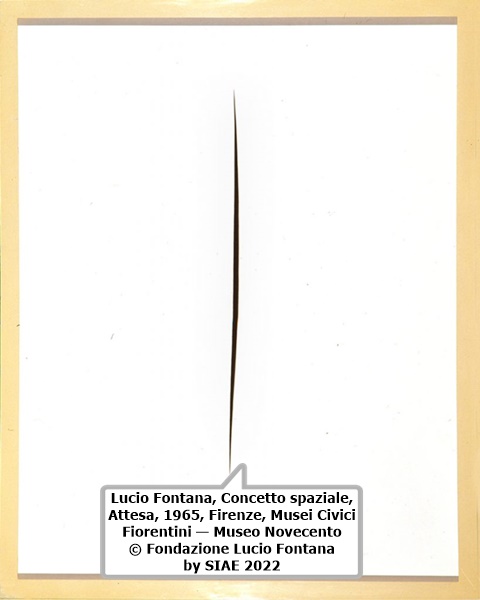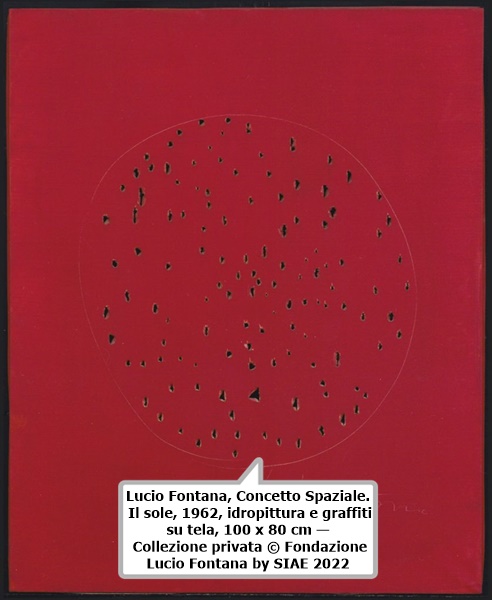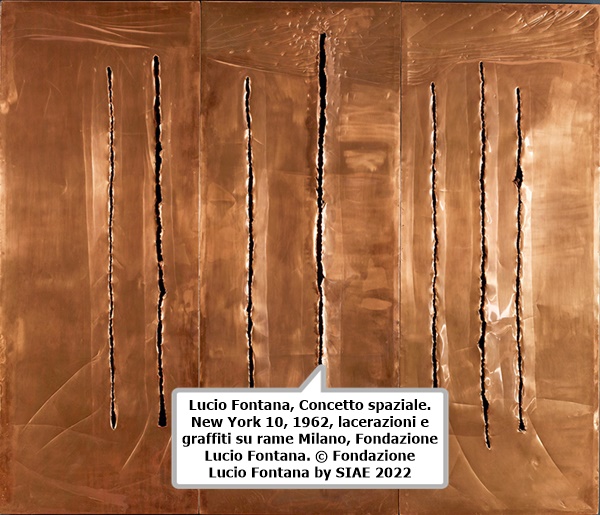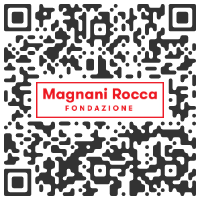"SELF PORTRAIT"
Lucio Fontana, Enrico Baj, Alberto Burri, Enrico Castellani, Luciano Fabro, Piero Manzoni, Giulio Paolini, Paolo Scheggi

Fondazione Magnani-Rocca
via Fondazione Magnani Rocca 4,Mamiano di Traversetolo (Parma).
tel. 0521 848327 / 848148
12 MARCH > 03 JULY 2022




Lucio Fontana (Rosario di Santa Fe 1899 - Comabbio 1968) is one of the undisputed pioneers and masters of twentieth century art, a radical and disruptive charismatic figure, a constant point of reference for the artists of subsequent generations. Promoter of numerous manifestos of the Spatialist Movement, starting with the Manifiesto Blanco of 1946 - which states that "matter, color and sound in motion are phenomena, the simultaneous development of which substantiates the new art" - initiates a process that it will lead him to the idea of introducing a new, unprecedented dimension in his works.
He is a total experiencer; after the works in marble, plaster and ceramic of the first period and the constant dialogue with prestigious architects, in 1949 he began his revolutionary works with the "Holes" that perforate the canvas; in 1951 he created the famous Neon Structure for the IX Triennale of Milan, passing, pioneeringly, from the works conceived specifically for experimental television broadcasts (1952) and arriving at the famous "Tagli" in 1958. In his complex and profitable path he exhibited in the most authoritative international museums and institutions, participating in numerous editions of the Venice Biennale and Documenta in Kassel.
"The discovery of the cosmos is a new dimension, it is infinity, so I pierce this canvas, which was the basis of all the arts and I created an infinite dimension, an x which, for me, is the basis of all contemporary art. Otherwise he keeps saying that the is a büs, and bye. "
from the interview with Lucio Fontana by Carla Lonzi in Self-portrait, 1969
Composed of about fifty works, the exhibition is held at the Villa dei Capolavori, headquarters of the Magnani-Rocca Foundation in Mamiano di Traversetolo near Parma, from 12 March to 3 July 2022, and is curated by Walter Guadagnini, Gaspare Luigi Marcone, Stefano Roffi.
The exhibition Lucio Fontana. Self-portrait originates from the relationship between the artist, absolute master of Spatialism and 20th century art, and the art historian Carla Lonzi, a pupil of the great Roberto Longhi, who revolutionized the idea of militant criticism with her volume of interviews Self-portrait. Accardi Alviani Castellani Consagra Fabro Fontana Kounellis Nigro Paolini Pascali Rotella Scarpitta Turcato Twombly edited by De Donato, Bari, in 1969.
The exhibition therefore narratively follows the conversation between Fontana and Lonzi, allowing the realization of an anthological, but not dogmatic, path, with works that touch the salient and peculiar moments of Fontanian research, an itinerary in the thought and practice of an artist who believed that art should be experienced through a new dimension, within which new technologies and materials also entered. Works from various periods are exhibited, from the sculptures of the Thirties to the “Spatial Concepts” (“Holes” and “Cuts”) from the Forties to the Sixties, as well as the bronze “Theaters” and “Natures”; spectacular are the huge New York 10 of 1962, copper panels with lacerations and graffiti, in dialogue with the light to evoke the sparkling modernity of the metropolis, and the very powerful La fine di Dio, 1963, a great work made in oil, gashes, holes, graffiti and sequins on canvas, emblematic of the artist's spatial and religious conception.
The path ends with works by Enrico Baj, Alberto Burri, Enrico Castellani, Luciano Fabro, Piero Manzoni, Giulio Paolini, Paolo Scheggi, coming from Fontana's personal collection, younger artists he followed and promoted. Particularly suggestive are the photographic series taken by Ugo Mulas in Fontana, of which two works belonging to the great photographer are also exhibited; one of them exhibits photographic documentation of the entire genesis, from the first "hole" to the finished work, unique in both the photographer's and the artist's history.
A peculiarity of the project is having recovered the audio of the original and integral conversation, where you can hear the direct voice of Fontana talking about his work, his life as an artist, his activity as a collector but also about experiences and adventures. daily (Lonzi will publish only part of the long interview in the 1969 volume). Fontana's words are used both as a sound installation and as a narrative thread throughout the course of the Self-portrait exhibition.
The exhibition boasts the support and loan of an important group of works from the Lucio Fontana Foundation in Milan. Other works of great importance are lent by Mart, the Museum of Modern and Contemporary Art of Trento and Rovereto, by the Museo Novecento in Florence, by CSAC, University of Parma, by the Intesa Sanpaolo Collection, by the Artistic Heritage of the Unipol Group, by the Barilla Collection of Modern Art, from the Ugo Mulas Archive, from the Cariparma Foundation Library, Donation Corrado Mingardi and from other prestigious Archives and private collections.
The catalog (Silvana Editoriale) is edited, like the exhibition, by Walter Guadagnini (former curator of two prestigious exhibitions at the Villa dei Capolavori), Gaspare Luigi Marcone (historian and curator of numerous projects on Italian artists of the twentieth century), Stefano Roffi (scientific director of the Magnani-Rocca Foundation). In addition to those of the curators, it contains contributions by Paolo Campiglio, Mauro Carrera, Lara Conte, Maria Villa, with the reproduction of all the works on display.
He is a total experiencer; after the works in marble, plaster and ceramic of the first period and the constant dialogue with prestigious architects, in 1949 he began his revolutionary works with the "Holes" that perforate the canvas; in 1951 he created the famous Neon Structure for the IX Triennale of Milan, passing, pioneeringly, from the works conceived specifically for experimental television broadcasts (1952) and arriving at the famous "Tagli" in 1958. In his complex and profitable path he exhibited in the most authoritative international museums and institutions, participating in numerous editions of the Venice Biennale and Documenta in Kassel.
"The discovery of the cosmos is a new dimension, it is infinity, so I pierce this canvas, which was the basis of all the arts and I created an infinite dimension, an x which, for me, is the basis of all contemporary art. Otherwise he keeps saying that the is a büs, and bye. "
from the interview with Lucio Fontana by Carla Lonzi in Self-portrait, 1969
Composed of about fifty works, the exhibition is held at the Villa dei Capolavori, headquarters of the Magnani-Rocca Foundation in Mamiano di Traversetolo near Parma, from 12 March to 3 July 2022, and is curated by Walter Guadagnini, Gaspare Luigi Marcone, Stefano Roffi.
The exhibition Lucio Fontana. Self-portrait originates from the relationship between the artist, absolute master of Spatialism and 20th century art, and the art historian Carla Lonzi, a pupil of the great Roberto Longhi, who revolutionized the idea of militant criticism with her volume of interviews Self-portrait. Accardi Alviani Castellani Consagra Fabro Fontana Kounellis Nigro Paolini Pascali Rotella Scarpitta Turcato Twombly edited by De Donato, Bari, in 1969.
The exhibition therefore narratively follows the conversation between Fontana and Lonzi, allowing the realization of an anthological, but not dogmatic, path, with works that touch the salient and peculiar moments of Fontanian research, an itinerary in the thought and practice of an artist who believed that art should be experienced through a new dimension, within which new technologies and materials also entered. Works from various periods are exhibited, from the sculptures of the Thirties to the “Spatial Concepts” (“Holes” and “Cuts”) from the Forties to the Sixties, as well as the bronze “Theaters” and “Natures”; spectacular are the huge New York 10 of 1962, copper panels with lacerations and graffiti, in dialogue with the light to evoke the sparkling modernity of the metropolis, and the very powerful La fine di Dio, 1963, a great work made in oil, gashes, holes, graffiti and sequins on canvas, emblematic of the artist's spatial and religious conception.
The path ends with works by Enrico Baj, Alberto Burri, Enrico Castellani, Luciano Fabro, Piero Manzoni, Giulio Paolini, Paolo Scheggi, coming from Fontana's personal collection, younger artists he followed and promoted. Particularly suggestive are the photographic series taken by Ugo Mulas in Fontana, of which two works belonging to the great photographer are also exhibited; one of them exhibits photographic documentation of the entire genesis, from the first "hole" to the finished work, unique in both the photographer's and the artist's history.
A peculiarity of the project is having recovered the audio of the original and integral conversation, where you can hear the direct voice of Fontana talking about his work, his life as an artist, his activity as a collector but also about experiences and adventures. daily (Lonzi will publish only part of the long interview in the 1969 volume). Fontana's words are used both as a sound installation and as a narrative thread throughout the course of the Self-portrait exhibition.
The exhibition boasts the support and loan of an important group of works from the Lucio Fontana Foundation in Milan. Other works of great importance are lent by Mart, the Museum of Modern and Contemporary Art of Trento and Rovereto, by the Museo Novecento in Florence, by CSAC, University of Parma, by the Intesa Sanpaolo Collection, by the Artistic Heritage of the Unipol Group, by the Barilla Collection of Modern Art, from the Ugo Mulas Archive, from the Cariparma Foundation Library, Donation Corrado Mingardi and from other prestigious Archives and private collections.
The catalog (Silvana Editoriale) is edited, like the exhibition, by Walter Guadagnini (former curator of two prestigious exhibitions at the Villa dei Capolavori), Gaspare Luigi Marcone (historian and curator of numerous projects on Italian artists of the twentieth century), Stefano Roffi (scientific director of the Magnani-Rocca Foundation). In addition to those of the curators, it contains contributions by Paolo Campiglio, Mauro Carrera, Lara Conte, Maria Villa, with the reproduction of all the works on display.
 | Lucio Fontana | |
 | Enrico Baj | |
 | Alberto Burri | |
 | Enrico Castellani | |
 | Luciano Fabro | |
 | Piero Manzoni | |
 | Giulio Paolini | |
 | Paolo Scheggi | |
mpefm ITALY art press release
Opening time :
From Tuesday to Friday 10 am-6pm (the ticket office closes at 5pm) - Saturday, Sunday and holidays 10 am-7pm (the ticket office closes at 6pm).
Closed Monday (open Easter Monday and Monday 25th April as public holidays).
PRICES
€ 12.00 also valid for permanent collections
€ 10.00 for groups of at least fifteen people
€ 5.00 for schools
PARTNERS
The exhibition is organized thanks to: CARIPARMA FOUNDATION, CRÉDIT AGRICOLE ITALIA.
Media partner: Gazzetta di Parma. With the collaboration of: Angeli Cornici, Bstrò, Cavazzoni Associati, Society for Mobility and Public Transport.
QR of this press release
in your smartphone, tablet

Closed Monday (open Easter Monday and Monday 25th April as public holidays).
PRICES
€ 12.00 also valid for permanent collections
€ 10.00 for groups of at least fifteen people
€ 5.00 for schools
PARTNERS
The exhibition is organized thanks to: CARIPARMA FOUNDATION, CRÉDIT AGRICOLE ITALIA.
Media partner: Gazzetta di Parma. With the collaboration of: Angeli Cornici, Bstrò, Cavazzoni Associati, Society for Mobility and Public Transport.
QR of this press release
in your smartphone, tablet








